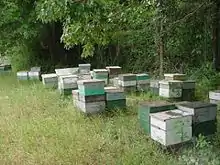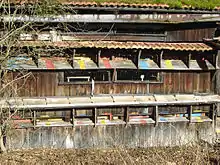Apiary
An apiary (also known as a bee yard) is a location where beehives of honey bees are kept. Apiaries come in many sizes and can be rural or urban depending on the honey production operation. Furthermore, an apiary may refer to a hobbyist's hives or those used for commercial or educational usage. It can also be a wall-less, roofed structure, similar to a gazebo which houses hives.

History
Apiaries have been found in ancient Egypt from prior to 2422 BCE where hives were constructed from moulded mud.[1] Throughout history apiaries and bees have been kept for honey and pollination purposes all across the globe. Due to the definition of apiary as a location where hives are kept its history can be traced as far back as that of beekeeping itself.[1] For more information on the history of beekeeping see the history and origins portions of the beekeeping article.
Etymology
First known usage of the word "apiary" was in 1654.[2] The base of the word comes from the Latin word "apis" meaning "bee", leading to "apiarium" or "beehouse" and eventually "apiary."[2]
Beekeepers may rarely be referred to as "apiarists" or "ones who tend apiaries."[3] By definition an apiary is a location where beehives are kept; although the word is also used to refer to any location where bees swarm and molt. The word apiarist typically refers to a beekeeper who focuses on just one species of bee. The word apiarist first appeared in print in a 1940 book written by Walter de Gruyter. It was a phrase coined by apiarists to describe how apiaries were maintained.
Structure
Apiaries may vary by location and according to the needs of the individual operation. Typically, apiaries are composed of several individual hives. For more information on specific hive structures see the beekeeping and beehive articles. In the case of urban beekeeping, hives are often located on high ground, which requires less space than hives located at lesser altitudes.[4] To direct the bees' path of flight in populous urban areas, beekeepers often construct tall fences which force the bees to fly higher and widen their search for food.[4]
Location

Apiaries are usually situated on high ground in order to avoid moisture collection, though in proximity to a consistent water source—whether natural or man-made—to ensure the bees' access.[5] Additionally, ample nectar supplies for the bees as well as relatively large amounts of sun are considered.[5] They are often situated close to orchards, farms, and public gardens, which require frequent pollination to develop a positive feedback loop between the bees and their food sources. This also economizes on the bees' pollination and the plants' supply of nectar.[6]
An apiary may have hive management objectives other than honey production, including queen rearing and mating. In the northern hemisphere, east and south facing locations with full morning sun are preferred. In hot climates, shade is needed and may have to be artificially provided if trees are not present. Other factors include air and water drainage and accessibility by truck, distance from phobic people, and protection from vandalism.
In the USA there are beekeepers — from hobbyists to commercial — in every state. The most lucrative areas for American honey production are Florida, Texas, California, and the Upper Midwest.[7] For paid pollination, the main areas are California, the Pacific Northwest, the Great Lakes States, and the Northeast.[7] Rules and regulations by local ordinances and zoning laws also affect apiaries.[8]
In recent years US honey production has dropped and the U.S. imports 16% of the world's honey.[9] Internationally, the largest honey producing exporters are China, Germany, and Mexico.[9] As in the United States the location of apiaries varies internationally depending on available resources and the operational need. For more information on nation-specific beekeeping see their respective articles, such as the Beekeeping in Nepal article.
Size
Apiary size refers not only to the spatial size of the apiary, but also to the number of bee families and bees by weight.[10] With ample space there is no limit to the number of hives or bee families which can be housed in an apiary. The larger the number of hives held in an apiary the higher the yield of honey relative to resources, often resulting in apiaries growing with time and experience.[10] Additionally a higher number of hives within an apiary can increase the quality of the honey produced.[10] Depending on the nectar and pollen sources in a given area, the maximum number of hives that can be placed in one apiary can vary. If too many hives are placed into an apiary, the hives compete with each other for scarce resources. This can lead to lower honey, flower pollen and bee bread yields, as well as higher transmission of disease and robbing.[11]
The size of an apiary is determined by not only the resources available but also by the variety of honey being cultivated, with more complex types generally cultivated in smaller productions. For more specific details on varieties see the classification portion of the honey article. The purpose of the apiary also affects size: apiaries are kept by commercial and local honey producers, as well as by universities, research facilities, and local organizations. Many such organizations provide community programming and educational opportunities. This results in varying sizes of apiaries depending on usage characteristics.[12]
The maximum size of a permanent apiary or bee yard may depend on the type of bee as well. Some honey bee species fly farther than others. A circle around an apiary with a three-mile (5 km) foraging radius covers 28 square miles (73 km2). A good rule of thumb is to have no more than 25–35 hives in a permanent apiary, although migrating beekeepers may temporarily place one hundred hives into a location with a good nectar flow.
Disease and decline
Apiaries may decline due to a scarcity of resources which can lead to robbing of nearby hives. This is especially an issue in urban areas where there maybe a limited amount of resources for bees and a large number of hives may be affected.[13]
Apiaries may suffer from a wide variety of diseases and infestations.[14] Throughout history apiaries and bees have been kept for honey and pollination purposes all across the globe. Due to the definition of apiary as a location where hives are kept its history can be traced as far back as that of beekeeping itself. In recent years Colony Collapse Disorder due to pesticide resistant mites have ravaged bee populations.[15] Beyond mites there are a wide variety of diseases which may affect the hives and lead to the decline or collapse of a colony. For this reason many beekeepers choose to keep apiaries of limited size to avoid mass infection or infestation. For more information on diseases which affect bee populations see the List of diseases of the honey bee.
References
- Kritsky, Gene (2017). "Beekeeping from Antiquity Through the Middle Ages". Annual Review of Entomology. 62: 249–264. doi:10.1146/annurev-ento-031616-035115. PMID 28141962.
- "Definition of APIARY". www.merriam-webster.com. Retrieved 2017-10-29.
- "Apiarist definition and meaning | Collins English Dictionary". www.collinsdictionary.com. Retrieved 2017-10-30.
- "Massachusetts Beekeepers Association Best Management Practices" (PDF). Massachusetts Beekeepers Association Best Management Practices. 1: 1–6. March 22, 2014.
- "Massachusetts Beekeepers Association Best Management Practices" (PDF). Massachusetts Beekeepers Association Best Management Practices. 1: 1–6. March 22, 2014.
- AGR (2016-04-27). "Apiary Program (honey bees)". Energy and Environmental Affairs. Retrieved 2017-10-29.
- "U.S. Honey Industry Report - 2016 | Bee Culture". Bee Culture. 2017-04-24. Retrieved 2017-10-29.
- "Beekeeping 101: Supplies, Plans and How To". Popular Mechanics. 2015-01-29. Retrieved 2017-10-30.
- "Honey: World Production, Top Exporters, Top Importers, and United States Imports by Country". World Trade Daily. 2012-07-28. Archived from the original on 2018-02-13. Retrieved 2017-10-30.
- Popescu A. 2013, RESEARCH CONCERNIG APIARY SIZE, HONEY YIELD AND BEEKEEPERS’ INCOME IN TELEORMAN COUNTY. Scientific Papers. Series "Management, Economic Engineering in Agriculture and rural development", Vol. 13 ISSUE 1, PRINT ISSN 2284-7995, 293-300.
- "Massachusetts Beekeepers Association Best Management Practices" (PDF). Massachusetts Beekeepers Association Best Management Practices. 1: 1–6. 2014-03-22.
- AGR (2016-04-27). "Apiary Program (honey bees)". Energy and Environmental Affairs. Retrieved 2017-10-29.
- "Massachusetts Beekeepers Association Best Management Practices" (PDF). Massachusetts Beekeepers Association Best Management Practices. 1: 1–6. March 22, 2014.
- von Büren, R.S.; et al. (2019). "High-resolution maps of Swiss apiaries and their applicability to study spatial distribution of brood diseases". PeerJ. 7: e6393. doi:10.7717/peerj.6393. PMC 6360077. PMID 30723636.
- "Natural Beekeeping in Your Backyard - Homesteading and Livestock - MOTHER EARTH NEWS". Mother Earth News. Retrieved 2017-10-30.
External links
| Look up apiary in Wiktionary, the free dictionary. |
| Wikimedia Commons has media related to Apiary. |
- The River Wey and Wey Navigations Community Site – a non-commercial site of over 200,000 words all about the Wey Valley and includes a photo-essay about honey bees and apiary
- National Honey Board – June 2005 press release
- http://www.apiary.site A nonprofit site for apiary and bee keepers (2019)
- Image of a young girl at an apiary, Los Angeles County, 1935. Los Angeles Times Photographic Archive (Collection 1429). UCLA Library Special Collections, Charles E. Young Research Library, University of California, Los Angeles.